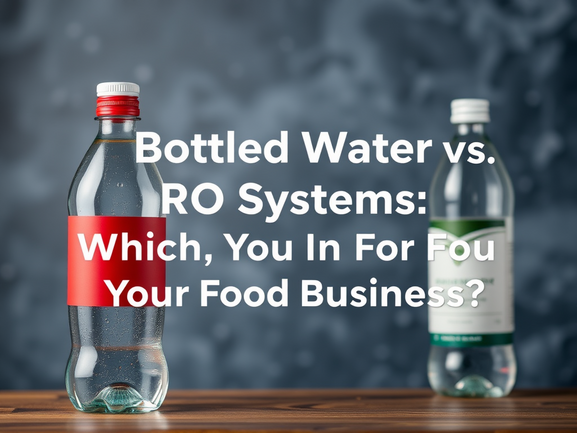Hydration That Works: Bottled Water vs. RO Systems for Your Food Business
Deciding whether to rely on bottled water deliveries or to install a reverse osmosis (RO) system can feel like a crossroads—one path promises instant ease, the other long-term gains in flavor, cost, and sustainability. In every café, brewery, or restaurant, water isn’t just a neutral ingredient; it’s the silent partner in every espresso shot, the lifeblood of dough proofing, and the backbone of ice clarity. According to industry veterans at Second Wind Water, clear, consistent water underpins over 90% of a drink’s character (Second Wind Water – Commercial Water System for Food Business).
On the bottled side, you’re essentially renting purity by the case. There’s no installation, no monthly filter swaps—just a simple tap and pour. But with each pallet comes a gnawing pile of single-use plastic and the unpredictable rollercoaster of delivery fees. The environmental toll of those discarded jugs is staggering; modern RO systems, by contrast, can eliminate up to 98% of bottle waste, and they even capture sediments that bottled water often ignores (Osmosisinfo – Do Reverse Osmosis Filters Remove Microplastics?).
Install an RO unit, and suddenly your team trades in storage headaches for a compact under-sink cabinet or a neat rack in the back of house. Though the upfront expense and occasional service calls may give you pause, the ROI shows up fast: fewer supply interruptions, dramatically lowered per-gallon costs, and happier chefs when that pure water makes spicy broths sing and delicate cocktails sparkle. Commercial kitchens have even reported up to a 50% reduction in component failures—coffee machines, ice makers, steam ovens—all grateful for the soft, mineral-balanced water flowing through them (Critical Process – Water Filtration in Food & Beverage Processing).
Imagine your pastry station: a consistent hydration level means dough rises exactly the way your head baker expects. Your barista? No more off-flavor complaints when municipal chlorine levels spike overnight. And your accountant can finally compare predictable monthly water bills instead of juggling mysterious surcharges and last-minute freezer space for bottled jugs. The clarity that RO delivers is as much financial and operational clarity as it is a boost to taste.
That said, bottled water still has its niche. For transient pop-ups, catered events, or tiny coffee carts, the “just add water” simplicity can be a lifesaver when you’re on the move. But for any venue focused on repeat visits, brand integrity, and eco-credibility, the switch to RO often feels like a no-brainer. When we crunch the numbers against the environmental benefits and the unwavering purity on tap, the scales tip decisively toward investing in an RO system.
Balancing the Books and the Planet: Cost Efficiency & Sustainability Showdown
Pinching pennies while reducing plastic waste seems like a juggling act, but it’s surprisingly straightforward once you line up the real costs of bottled water against those of an RO system. On day one, bottled water wins the prize for “cheapest upfront commitment.” Yet a closer look at delivery fees, storage rentals, and recycling surcharges reveals that the real price tag per gallon often sits between $0.20 and $1.00 (Second Wind Water – Commercial Water System for Food Business).
In contrast, RO-treated water can cost mere pennies per gallon. In many foodservice operations, the monthly savings from pennies on the gallon quickly offset the installation and filter replacement investments. Second Wind Water’s commercial clients frequently report slashing water expenses by over 90% within months of flipping the switch. Meanwhile, bottled water racks up not just costs but carbon too—trucking heavy jugs, refrigerating warehouses, discarding plastics.
| Metric | Bottled Water | RO System |
|---|---|---|
| Per Gallon Cost | $0.20–$1.00 | $0.01–$0.05 |
| Annual Plastic Waste | ~2,000 bottles (for 10,000 gallons) | 0 bottles |
| Equipment Maintenance Impact | Higher scale buildup | 30–50% longer lifespan (Webstaurant Store – The Importance of Water Filters for Your Restaurant Equipment) |
| Carbon Emissions | High (transport & refrigeration) | Low (in-house generation) |
Operational efficiency isn’t just about the water bill. Hard minerals in untreated tap or low-grade bottled water leave scale in boilers, coffee machines, and dishwashers, triggering more frequent repairs and unplanned downtime. When pre-treatment via carbon blocks, sediment filters, and RO membranes is in place, equipment enjoys cleaner feed water—and businesses save big on service calls (Brother Filtration – Water Filtration in the Food and Beverage Industry).
In a world where consumers increasingly vote with their wallets for eco-friendly brands, ditching plastic jugs and embracing a closed-loop RO solution becomes a powerful statement. It’s not just a ledger line; it’s proof you care about the planet. And on the bottom line, the math is unambiguous: lower recurring costs plus reduced waste equals a win-win for finance and sustainability.
From Flavor to Filtration: Ensuring Pure, Palatable Water Every Time
The clarity of water isn’t a trivial detail—it directly influences how flavors bloom or tomb in every beverage or dish. Water often composes over 90% of a drink, so even a whisper of chlorine or a whisper of heavy minerals can tip a crisp cocktail into flat territory or make coffee taste metallic (Second Wind Water – Commercial Water System for Food Business).
Flavor consistency is golden in foodservice. A bakery’s dough hydration, fermentation rate, and final crumb structure all hinge on mineral balance. In the brewery world, just 10 parts per million of calcium shift can change mash pH and yeast activity, skewing your signature profiles. Coffee pros, too, know that dissolved solids and water hardness dictate extraction efficiency. Uneven water invites unpredictable flavor wheels, and that’s a recipe for disappointed regulars.
Enter multi-stage filtration: depth or sediment prefilters catch rust and grit, carbon blocks strip chlorine and organic byproducts, and the RO membrane polishes out nearly every dissolved ion. This layered approach delivers water so neutral and pure that it lets the roast’s nuance sparkle, the hops’ brightness bloom, and your soup bases sing true (Critical Process – Water Filtration in Food & Beverage Processing).
We’ve also seen teams fine-tune post-RO treatments—like adding a dash of calcium or specialty mineral cartridges—to tailor final water profiles for particular coffee origins or craft beer styles. This level of control is unheard of with bottled water or basic tap treatments. It’s why chefs and brewers alike swear by RO systems: they become silent flavor partners that never steal the show.
And reliability matters. When water quality is locked down, there’s no panicked “Why does my iced tea taste funny?” in the middle of happy hour. Production flows smoothly. Customers trust that every sip of your signature drink will taste exactly as they remember. Over time, that trust translates into loyal followers and a reputation for excellence—well worth the investment in advanced filtration.
Behind the Scenes: Setup, Upkeep, and Waste Management Realities
Installing an RO system is more like orchestrating a symphony than slapping in a single filter. First, you route incoming water through a sediment prefilter—sometimes housed in rugged bag casings—to trap rust and sand. Next, a carbon block unit shaves off chlorine, chloramine, and organic odors. Finally, the water hits the RO membrane under the sink or in a utility rack, where semi-permeable magic whittles out hard minerals, microbes, and residual organics (Commercial Filtration Supply – Types of Filtration Systems for Restaurants; Critical Process – Water Filtration in Food & Beverage Processing).
Keep in mind that regular maintenance is the unsung hero of great water. Sediment filters demand swapping every three to six months, carbon blocks every six to twelve, and the RO membrane roughly every two to three years—although heavy-use restaurants often advance that cycle. Monthly pressure checks, o-ring inspections, and line sanitizations are the quiet rituals that prevent surprise shutdowns (Webstaurant Store – The Importance of Water Filters for Your Restaurant Equipment).
For small cafés or test kitchens, an under-sink RO system can tuck neatly beneath counters, connecting directly to the bar spigot. Large venues often opt for centralized racks with booster pumps, automatic shut-off valves, and even UV sterilization to guard against late-night bacterial creep. The extra complexity may sound daunting, but professional installers handle much of the heavy lifting—ensuring your chefs focus on food, not filter housings (Osmosisinfo – Under-Sink Reverse Osmosis System Basics).
And what about dark water and brine reject? Modern RO units divert concentrate through drain saddles or air-gap faucets, ensuring no utensil soaking or cross-contamination. With proper drain installation, the system quietly deletes dissolved solids without fuss or flood risk. Managing that waste stream responsibly—sometimes even capturing reject water for mop buckets or equipment rinses—turns what could seem like unnecessary waste into a resource that keeps your back-of-house ops tidy and compliant.
Routine servicing agreements, clear maintenance logs, and staff training on filter changes make this otherwise behind-the-curtain work nearly invisible. Once the system hums along, the kitchen team enjoys unbroken access to crystal-clear water, stress-free, day in and day out.
Key Takeaways & Final Words
At the end of the shift, the choice between bottled water and an RO system often boils down to scale and strategy. For low-volume, ephemeral setups, bottled water’s grab-and-go simplicity ticks the convenience box. But for coffee shops aiming to nail every espresso pull, breweries crafting consistent batches, and bustling kitchens chasing flavor precision, an RO solution represents an investment that pays dividends in quality, cost control, and green credentials (Critical Process – Water Filtration in Food & Beverage Processing).
Financially, you trade recurring delivery fees and unpredictable surcharges for predictable filter budgets and negligible per-gallon costs. Operationally, you swap storage shackles and supply-chain headaches for on-demand purity and protected equipment. Environmentally, it’s a switch from mountains of plastic waste to a near-closed-loop system that dramatically shrinks your carbon footprint (Brother Filtration – Water Filtration in the Food and Beverage Industry).
Every kitchen deserves water that doesn’t play hide-and-seek with flavor or sabotage costly machinery. Investing in a commercial RO system, complete with prefilter stages and professional maintenance, invites consistency into every cup, batch, and pot. For venues serious about taste, sustainability, and the bottom line, it’s the clear choice. To dive deeper into how RO works and why it matters, explore advanced insights on Osmosisinfo – Understanding Reverse Osmosis Water Filtration.
So go ahead—finalize your hydration strategy, knowing you’ve weighed flavor, finances, and footprints. Here’s to water that works as hard as you do, glass after glass, plate after plate.
Sources
- Brother Filtration – Water Filtration in the Food and Beverage Industry
- Commercial Filtration Supply – Types of Filtration Systems for Restaurants
- Critical Process – Water Filtration in Food & Beverage Processing
- Osmosisinfo – Do Reverse Osmosis Filters Remove Microplastics?
- Osmosisinfo – Under-Sink Reverse Osmosis System Basics
- Osmosisinfo – Understanding Reverse Osmosis Water Filtration
- Second Wind Water – Commercial Water System for Food Business
- Webstaurant Store – The Importance of Water Filters for Your Restaurant Equipment

Dr. Tina M. Nenoff is a senior scientist and Sandia Fellow at Sandia National Laboratories, renowned for her pioneering work in nanoporous materials. Her research focuses on the chemistry of confinement and reactivity of ions and molecules within these materials, leading to significant advancements in environmental remediation and energy applications. Notably, she played a crucial role in developing crystalline silicotitanates used to remove radioactive cesium from contaminated seawater following the Fukushima Daiichi nuclear disaster.


